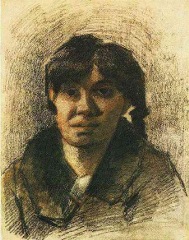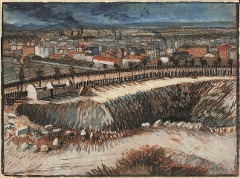Antwerp and Paris · 4114 dagen geleden by Ad van den Ende
Antwerp
At the end of November 1885 Vincent settled in Antwerp.
To Theo van Gogh. Antwerp, on or about Thursday, 26 November 1885
“My dear Theo,
Wanted to let you know that I’m in Antwerp and have already seen various things. I’ve rented a little room, rue des Images No. 194, above a paint merchant, for 25 francs a month. So when you write, please address your letter there instead of Poste restante.
(…)
But — I’ve seen extraordinarily little in the shops, virtually nothing — one little painting not even as big as a hand, as good as Raffaëlli, otherwise nothing special, and I’m afraid that the trade is categorically as quiet as the grave. Still — it’s a good old Dutch saying — don’t despair.
I like Antwerp, have explored various parts of the city, it’s authentic down by the wharves.
Well — it can’t do any harm to know Antwerp a little, though it’ll probably be the same as everything and everywhere, that’s to say disillusioning, but yet with its own subtle distinctions. And besides, it’s good to have a change sometimes.
Regards, write soon if you will.”
To Theo van Gogh. Nuenen, on or about Friday, 20 November 1885.
“As regards my certainly feeling the lack of a studio in Antwerp, yes, that’s so. But I have to choose between a studio without work here, and work without a studio there. I took the latter. And with pleasure that’s actually so great that it feels to me like a return from exile.”
To Theo van Gogh. Antwerp, Saturday, 19 December 1885.
“I’ve been to see someone else with my view of Het Steen, who thought the tone and colour good, who was in a state of confusion drawing up his inventory and is in small premises, though, but where I could go back after the New Year. It’s a good thing for when there are foreigners who want to have a souvenir of Antwerp, and for this reason I’ll make a few more in the same genre of townscapes.
Yesterday, for example, I drew a few studies for a thing in which one sees the cathedral. And similarly I also have a small one of the Park. However, I’d rather paint people’s eyes than cathedrals, for there’s something in the eyes that isn’t in the cathedral — although it’s solemn and although it’s impressive — to my mind the soul of a person, even if it’s a poor tramp or a girl from the streets, is more interesting. I consequently believe that nothing helps one progress so directly as working with a model. Of course it’s a great problem to have to pay the models; we’re at a stage where it comes down to energy and the paintings will have to be energetic in order to find buyers.”
To Theo van Gogh. Antwerp, on or about Sunday, 6 December 1885
“Yesterday I was in the Scala café concert, something like the Folies Bergères10 — I thought it was tedious and hackneyed, of course, but — I amused myself looking at the audience. There were magnificent women’s heads, really extraordinarily fine, among the worthy bourgeois folk in the back rows, and on the whole I find what they say about Antwerp true indeed, that the women are good-looking here. (…)
One evening I saw a popular dance for sailors &c. down by the docks — it was quite charming and all very respectable. That won’t be the case at all these dances, though. No one there was drunk, for instance, nor did anyone drink much.
There were very good-looking girls there, the best-looking of whom was ugly. I mean, a figure that struck me like an amazingly beautiful Jordaens or Velázquez or — Goya — was one in black silk, probably some inn landlady or other, with an ugly and irregular face, but with vivacity and piquancy à la Frans Hals. She danced excellently in an old-fashioned manner — among others, once with a well-to-do little farmer type who had a large green umbrella under his arm, even while he was waltzing amazingly fast. Other girls were wearing ordinary jackets and skirts and red scarves — the sailors, cabin-boys &c., quite charming. Retired ship’s captain types who came to watch. Extraordinarily authentic. It does one good to see people who are really enjoying themselves.”
Vincent “drew several portraits, including one of an inward looking woman with plaited hair”. (Van Heugten)
In Januari1885 Vincent enrolled in The Royal Academy of Fine Arts. “Here he embarked upon drawing from plaster casts with some enthousiasm, even though he did not agree with the theoretical approach of his teachers. They emphasized the importance of contours in life drawing, while Van Gogh had trained himself very successfully during his time in Nunen to construct a figure by concentrating on its volume.
These divergent artistic principles were wholly incompatible, and his study at the academy was doomed to failure from the very start.” (Van Heugten)
Paris
On 28 Febrary 1886 Vincent moved to Paris. There he hoped to broaden his horizons. To Theo van Gogh. Paris, on or about Sunday, 28 February 1886 “My dear Theo, Don’t be cross with me that I’ve come all of a sudden. I’ve thought about it so much and I think we’ll save time this way. Will be at the Louvre from midday, or earlier if you like. A reply, please, to let me know when you could come to the Salle Carrée. As for expenses, I repeat, it comes to the same thing. I have some money left, that goes without saying, and I want to talk to you before spending anything. We’ll sort things out, you’ll see. So get there as soon as possible. I shake your hand. Yours truly, Vincent”Seated girl
In he studio of the French painter Fernand Cormon Vincent drew from nude models and from plaste casts.
A guinguette
In Paris he discovered that his style of painting was dark and old-fashioned. During a year he focused his attention on still life for the study of colour.
To Willemien van Gogh. Paris, late October 1887.
“Last year I painted almost nothing but flowers to accustom myself to a colour other than grey, that’s to say pink, soft or bright green, light blue, violet, yellow, orange, fine red. And when I painted landscape in Asnières this summer I saw more colour in it than before. I’m studying this now in portraits. “
Entrance to the Moulin de la Galette
Shed with sunflowers
Gate in the Paris Ramparts
while others are large and drawn in a looser style.“ (Van Heugten)
Suburb of Paris, seen from Montmartre
For the first time Vincent drew real watercolours; these intensified the brightness and the contrasts of complementary colours.
Red and green, orange and blue, yelloe and purple are complementary colours. If placed next to each other the result can be very expressive. Vincent constantly searched for contrasts of this kind.
Vicent had started to collect graphic work of Japanese masters. He admired and followed them.
Hiroshige A hundred views of famous places in Edo
“There are striking similarities: the bright colours, the characteristic compositions, daring persprctives and tiny figures populating the scene. (…) in his dawings made in the summer of 1887 theJapanese models set the tone.
(…)
Van Gogh was well aware that his artistic prospects had dramatically improved in Paris. He was full of confidence when he moved to Arles, a town in Provence, in February 1888, and it was there that his draughtsmanship was to achieve greatness.” (Van Heugten)














